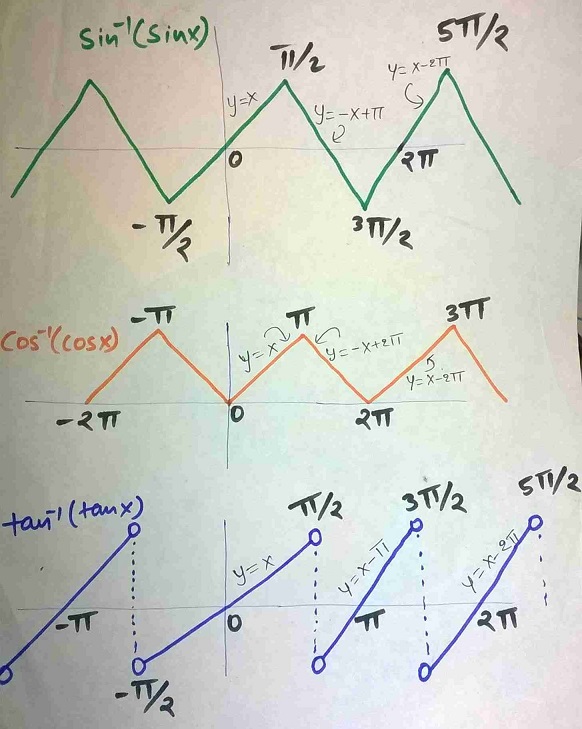The graphs for the 3 functions will be as follows:

Now we can precisely define and differentiate the functions in the given intervals using the above graphs as follow:
sin-1(sinx) = {
x when x ∈ [0, π/2]
π - x when x ∈ [π/2, 3π/2]
x - 2π when x ∈ [3π/2, 2π].
}
It can be seen from the graph of sin-1(sinx) that it is not smooth at x = π/2 and x = 3π/2.
Hence it is continuous but not differentiable at x = π/2 and x = 3π/2.
At all other points the function can be easily differentiated using the above definitions and we will get
1 when x ∈ [0, π/2) ⋃ (3π/2, 2π] and
-1 when x ∈ (π/2, 3π/2).
cos-1(cosx) = {
x when x ∈ [0, π]
2π - x when x ∈ [π, 2π]
}
It can be seen from the graph of cos-1(cosx) that it is not smooth at x = 0, x = π and x = 2π.
Hence it is continuous but not differentiable at x = 0, x = π and x = 2π.
At all other points the function can be differentiated using the above definitions and we will get
1 when x ∈ (0, π) and
-1 when x ∈ (π, 2π).
tan-1(tanx) = {
x when x ∈ [0, π/2)
x - π when x ∈ (π/2, π]
}
The value of this function is not defined at x = π/2.
It can be seen from the graph of tan-1(tanx) that it is not continuous at x = π/2.
Hence it is neither continuous nor differentiable at x = π/2.
At all other points the function can be differentiated and we will get
1 when x ∈ [0, π/2) ⋃ (π/2, π].
How to draw the graphs?
for example consider sin-1(sinx)
1. Domain of this function will be the domain of (sinx) i.e. the set of all real numbers.
2. Range of this function will be the range of sin-1x i.e. [-π/2, π/2].
3. The function is bonded between [-π/2, π/2].
4. The inner function i.e. sinx of this composite function is a periodic function so the composition could be a periodic function with same period.
5. Since both sin(x) and sin-1(x) are odd fuctions the composition should be an odd function.
6. sin-1 and sin are inverse of each other so intutively at least in some part of the graph, they should cancel the effect of each other leaving behind only x.
7. Checking the value of function at various values of x.
All these ideas can be combined to get a rough idea about the graph of this functions, similarly for the other two functions too.